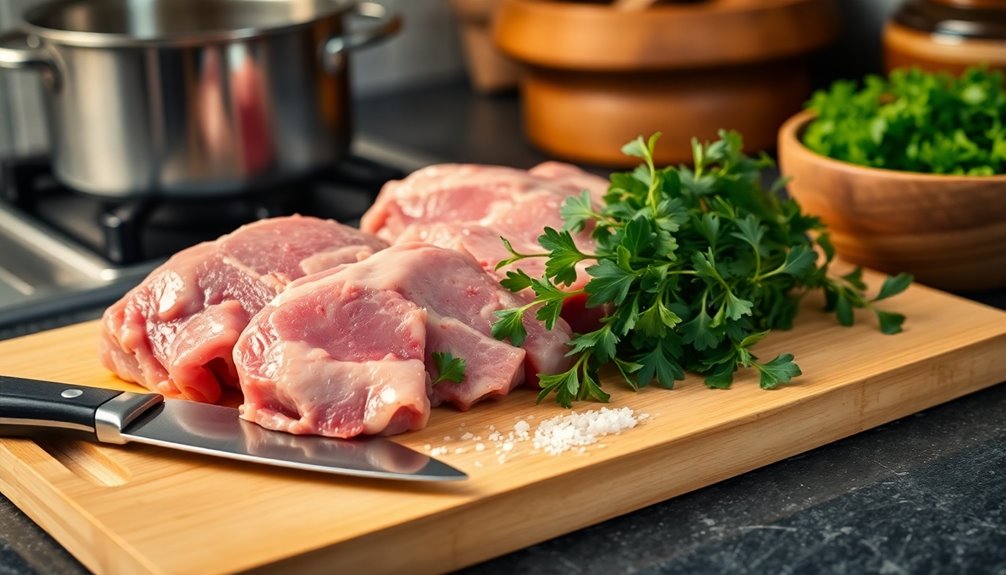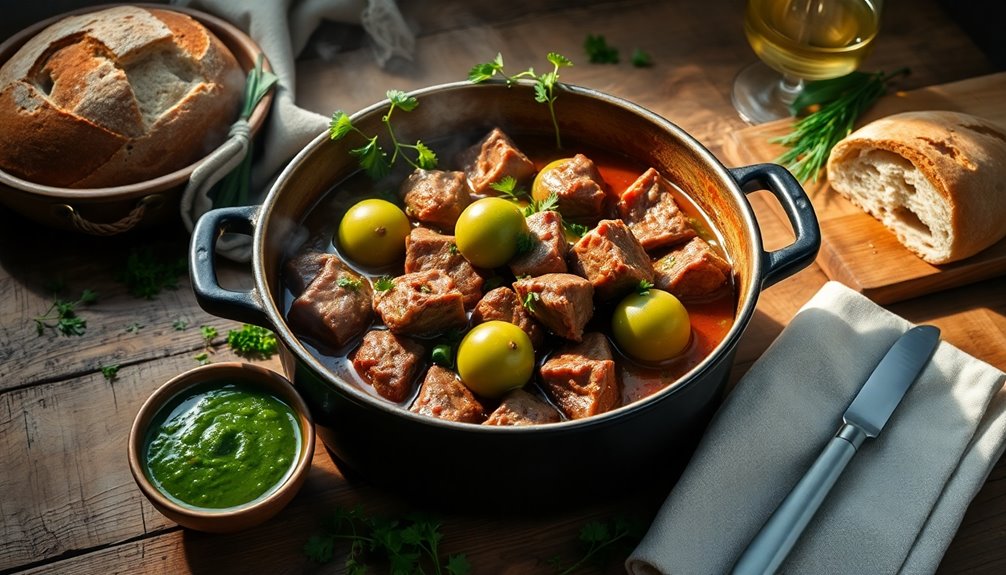Chakapuli is a traditional Georgian dish that combines tender lamb or veal with the tartness of sour plums and fresh herbs. It's typically prepared for festive occasions, especially during Orthodox Easter. You'll love how the vibrant flavors meld together in this aromatic stew, often enhanced with dry white wine and served hot. Pair it with Georgian bread for a true taste of hospitality. Discover more about its cooking methods and cultural significance as you explore further.
History

Chakapuli, a vibrant symbol of Georgian culinary tradition, has its roots in the Kakheti region, where it's often prepared for Orthodox Easter celebrations.
Chakapuli, a cherished Georgian dish from Kakheti, embodies the spirit of Orthodox Easter celebrations with its vibrant flavors.
This dish showcases the unique blend of lamb, sour plums, and tarragon, embodying the arrival of spring in Georgian cuisine.
Historically, Chakapuli reflects the practices of Georgian villagers who skillfully utilized seasonal ingredients to craft hearty meals.
Its preparation follows a traditional method that highlights the importance of community and family, making it a staple during festive occasions.
The dish's cultural significance is evident as it brings people together, celebrating hospitality and love through food.
Regional variations of Chakapuli further illustrate Georgia's diverse agricultural landscape and culinary heritage.
Recipe

Chakapuli is a delightful and aromatic Georgian stew that showcases the rich flavors of lamb or veal, enhanced by the unique tang of unripe green plums, known as tkemali. This dish is especially popular during the spring months when fresh ingredients are abundant. The combination of fresh herbs and the slow cooking process allows the meat to become tender and infused with a vibrant flavor profile that's both hearty and refreshing.
To prepare Chakapuli, you'll need to gather fresh herbs and high-quality meat to ensure the best taste. The cooking method involves browning the meat to lock in flavor, followed by simmering it in dry white wine and baking in the oven for a couple of hours. This slow cooking technique allows the flavors to meld beautifully, making it an ideal dish for family gatherings or festive occasions.
Ingredients:
- 1 kg lamb or veal, cut into chunks
- 2 cups dry white wine
- 2 cups unripe green plums (tkemali), pitted
- 1 large onion, finely chopped
- 4 cloves garlic, minced
- 1 bunch fresh tarragon, chopped
- 1 bunch fresh coriander, chopped
- 1 bunch fresh parsley, chopped
- 4-5 spring onions, chopped
- Salt and pepper to taste
- Traditional Georgian bread for serving
To cook the Chakapuli, preheat your oven to 180°C (350°F). In a large pot, heat some oil over medium heat and brown the chunks of lamb or veal on all sides. Once browned, remove the meat and set it aside.
In the same pot, add the chopped onion and garlic, sautéing until they become translucent. Return the meat to the pot, pour in the dry white wine, and season with salt and pepper. Bring to a boil, then cover and transfer the pot to the preheated oven. Bake for about 1.5 to 2 hours, stirring occasionally.
About 15 minutes before serving, add the tkemali sauce and fresh herbs, mixing well to combine.
When preparing Chakapuli, be sure to use fresh ingredients for the best flavor and consider adjusting the amount of tkemali sauce based on your preference for tanginess. If you can't find unripe green plums, feel free to use store-bought tkemali sauce for convenience.
Additionally, pairing the stew with traditional Georgian bread will enhance your dining experience, allowing you to soak up all the delicious sauce. Enjoy this hearty dish with family and friends for a truly authentic Georgian meal!
Cooking Steps

To start cooking your Chakapuli, you'll want to prepare the lamb and tarragon, making sure to season and brown the meat first.
Then, add the chopped green onions and sour plum sauce, letting the flavors come together.
Finally, simmer everything with fresh herbs for a deliciously rich dish.
Step 1. Prepare Lamb and Tarragon

Start by patting the lamb dry and seasoning it with salt and pepper.
Brown the lamb in batches over medium heat to develop flavor, then set it aside.
Next, cook diced onion until softened, and add minced garlic, cooking until fragrant.
This builds a savory base for your lamb stew.
Deglaze the pan with dry white wine, simmering until the alcohol smell dissipates.
Layer the browned lamb back into the pot with tarragon leaves and tkemali sauce, followed by chicken stock.
Bring the mixture to a boil, cover, and transfer it to the oven for slow cooking.
After cooking, stir in additional tarragon and tkemali sauce, letting it simmer before serving warm with traditional bread.
Step 2. Add Chopped Green Onions

Incorporate the chopped green onions just before finishing your Chakapuli to enhance the dish's flavor and texture. Roughly chop two bunches of fresh green onions and add them to the pot during the final cooking stages.
This timing is crucial; it allows the vibrant chopped greens to retain their crispness while melding beautifully with the richness of the lamb and other ingredients. The sharp, fresh flavor of green onions elevates the overall taste profile, making your Chakapuli even more delicious.
Plus, these nutritious additions offer vitamins A and K, contributing both flavor and health benefits. Remember, using fresh, tender green onions will significantly impact the dish's overall experience, so choose wisely!
Step 3. Add Sour Plum Sauce

Adding sour plum sauce to your Chakapuli is a game-changer that enhances the dish's flavor profile. Tkemali, made from sour green plums, adds a unique tartness that perfectly balances the richness of the lamb.
As you near the end of cooking your Georgian stew, stir in the sauce, letting it meld with the other flavors for about five minutes. If you can't find fresh sour plums, Tkemali sauce is a great substitute to maintain the authentic taste.
Step 4. Simmer With Fresh Herbs

To create a rich and aromatic Chakapuli, begin by browning the lamb in oil until it's nicely seared.
Then, add diced onions and cook until softened, building a flavorful base for your stew.
Deglaze the pan with dry white wine, letting it reduce to infuse the lamb with acidity.
Next, stir in fresh tarragon, spring onions, and chopped garlic, layering them with the meat to enhance the aroma.
Add the tkemali sauce, which brings a tangy kick that complements the richness of the lamb and herbs.
Finally, allow the dish to simmer gently, adjusting the liquid as needed to ensure the herbs release their vibrant flavors while the lamb becomes tender and succulent.
Step 5. Add Fresh Coriander Leaves

Finish your Chakapuli by stirring in a generous handful of finely chopped fresh coriander leaves just before serving. This step is crucial, as adding fresh green coriander at the end preserves its vibrant flavor and nutrients.
Rinse the leaves thoroughly, then chop them finely to ensure their aromatic qualities spread evenly throughout the stew. The bright, citrusy notes of coriander beautifully complement the tanginess of the tkemali and the richness of the lamb, elevating your dish to new heights.
Using fresh coriander instead of dried enhances the overall freshness, making each bite more delightful. So, don't skip this step—your Chakapuli will thank you for that final touch of fresh coriander!
Final Thoughts

As you explore the vibrant flavors of Chakapuli, it's clear that this dish is more than just a meal; it's a celebration of Georgian culture and tradition.
The tender lamb, simmered in a rich broth of amber wine and tangy sour plum sauce, creates an unforgettable experience. Fresh green coriander and other herbs infuse the dish with zesty notes, capturing the essence of springtime, especially during Orthodox Easter festivities.
The cooking process, taking about 1.5 to 2 hours, ensures the meat absorbs all the flavorful ingredients, offering you a taste of Georgia's culinary heritage.
Enjoy Chakapuli hot, paired with traditional Georgian bread and the same white wine, to truly appreciate its unique and delicious flavors.
Frequently Asked Questions
What Is the Meaning of Chakapuli?
The meaning of "Chakapuli" comes from Georgian words that relate to its cooking method and key ingredients.
You'll find "chakha," which means to boil, and "puli," referring to an herb. Together, they reflect the dish's preparation and the importance of herbs in the recipe.
This highlights the dish's cultural roots, showcasing how language ties into culinary practices, revealing a deeper connection to Georgia's culinary heritage and traditions.
What Is the Purple Fruit in Georgian Stew Chakapuli?
The purple fruit you're curious about is the unripe green plum, known as tkemali.
This fruit brings a unique tartness to dishes, making it a popular ingredient in Georgian cuisine.
When you taste a dish that uses tkemali, you'll notice how its sour flavor enhances the overall profile.
If you can't find tkemali, you might try tomatillos, as they offer a similar tangy taste that can substitute effectively.
Where Is Chakapuli From?
You might think every dish has a singular origin, but many have rich histories tied to specific regions.
Chakapuli hails from the Kakheti region of Georgia, a place known for its vibrant culinary traditions. This area emphasizes local ingredients and seasonal flavors.
As you explore Georgian cuisine, you'll discover that each dish tells a story, and Chakapuli is no exception, showcasing the unique flavors and heritage of its homeland.
Is Chakapuli Good?
You'll find that many people consider this dish to be incredibly good.
Its unique blend of flavors, combining tender meat with tangy elements, creates a refreshing experience for your palate. If you enjoy hearty meals rich in taste and nutrition, you're likely to appreciate it.
Plus, its aromatic herbs add an enticing fragrance that makes the dish even more appealing.









